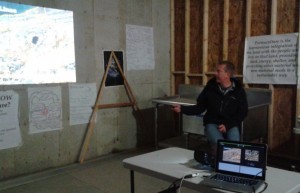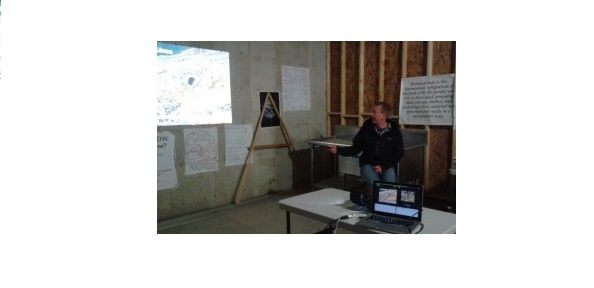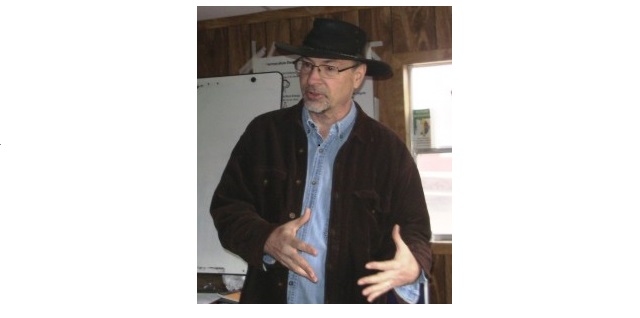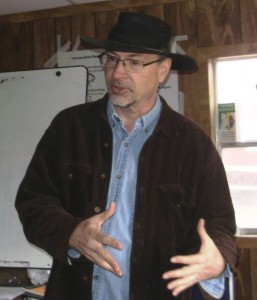
by Trudy Thomas
There’s a saying in Colorado: “Whiskey’s for drinkin’, water’s for fightin’ over.” Permaculturist Jason Gerhardt knows only too well the truth of that sentiment, as he works to change state water management policy.
Gerhardt, who holds a degree in sustainable design, spoke at the May class of Pikes Peak Permaculture’s 2015 Permaculture Design Course (PDC.)
The struggle for change got a little bump in 2009 when a law was passed allowing residents without access to public water to capture it. But Colorado officials have their sights set on stopping city dwellers from doing the same. Not only can we not collect it, we are forbidden from directing its flow to trees or plants. It is permissible to use rain gutter extensions to direct water away from a home or building, but if the intent is to water landscape, then folks are technically breaking the law.
Rainwater harvesting’s illegality did not stop Gerhardt from talking about its benefits. As a consultant, he calculated the harvesting potential of seven homes in a Boulder cul-de-sac. Taking into consideration an average precipitation rate of 18 inches a year, he calculated roof catchment and earth works capabilities, confirming that enough moisture fell from the sky to exceed what the cul-de-sac residents consumed. If Colorado residents were allowed to capture and store rainwater, be it from the roofs of their homes or landshaping techniques, Gerhardt suggested it could go a long way toward mitigating drought in cities of the American West.
Unfortunately, laws and people are slow to change even when faced with the facts. Water rights holders south of us are afraid if we interrupt the flow of water it won’t get to them. But a 2007 Colorado Water Conservation Board study showed that only 3 percent of precipitation makes it to rivers anyway. A whopping 97 percent is absorbed by plants and/or evaporated back into the big blue.
Gerhardt and other advocates are pulling out the whiskey as they wrangle with officials over state greywater regulations. Although greywater – water from showers, bathroom sinks and washing machines – was legalized by the Colorado legislature in 2013, it awarded cities and counties the power to issue permits and called for public health regulations. The details of those regulations are still being negotiated.
Related content: See photos of tree expert Don Chilo showing the class how to graft a tree
Water drama began early in the last century when lawmakers divvied up the Colorado River between 7 western states: Wyoming, Utah, Colorado and New Mexico in the north; Arizona, Nevada and California in the south. Since then, passage of other compacts, federal laws, court decisions and regulations governing river management have created the complexity known as The Law of the River.
The Law remains largely unchanged, but circumstances have not. A warming climate, lack of precipitation and burgeoning development on the Colorado Front Range have helped reduce the river to a trickle at the Gulf of California. Further, low water levels have endangered fish and degraded river ecology.
Worldwide, overuse of fertilizers in runoff has contributed to algae plumes where rivers reach the ocean, developing dead zones. The Mississippi River at the Gulf of Mexico is one such example where excess nitrogen in the water has facilitated the growth of algae. In excess, algae deprive ocean plants and animals of oxygen. The result is that everything dies except for a few resilient species.
But not everyone values expediency over quality of life.
“Permaculture asks how do we meet our needs and improve the ecosystem while meeting those needs rather than degrading the ecosystem,” Gerhardt says.

Reshaping property so that water is directed from the highest point on the land and, using gravity, moving it across the landscape is one way to accomplish this. The use of bowls, berms, swales and terraces slows the water down, allowing the earth to absorb it. Further, plants fed by rainwater thrive without the chlorine contained in public water.
Directing water across the landscape says Gerhardt filters out toxins and water is absorbed and stored in the humus layer. This process is especially helpful when weather events become extreme and erratic, be it flood or drought.
Gerhardt described other harvesting methods including redirecting street runoff by curb-cutting, a practice used successfully in arid Tucson. The water is redirected to the soil, where organisms, particularly fungi, help mitigate street pollutants.
Green roofing filters rainfall, check dams (terraces across the banks of rivers) slow water flow and, in rural areas, keylines (where the slope goes from steep to flat) serve to create efficient water management plans.
Gerhardt’s hope for Colorado to embrace green infrastructure may take a while. But that doesn’t seem to get him down. When he’s not joking about getting lawmakers together to drink and fight over water, he’s waxing poetic.
“Water is one of the main mediums by which all life is connected,” Gerhardt says. “By concentrating on this one stream, we can solve many of the world’s problems.”
For more about Jason, visit Real Earth Design.





